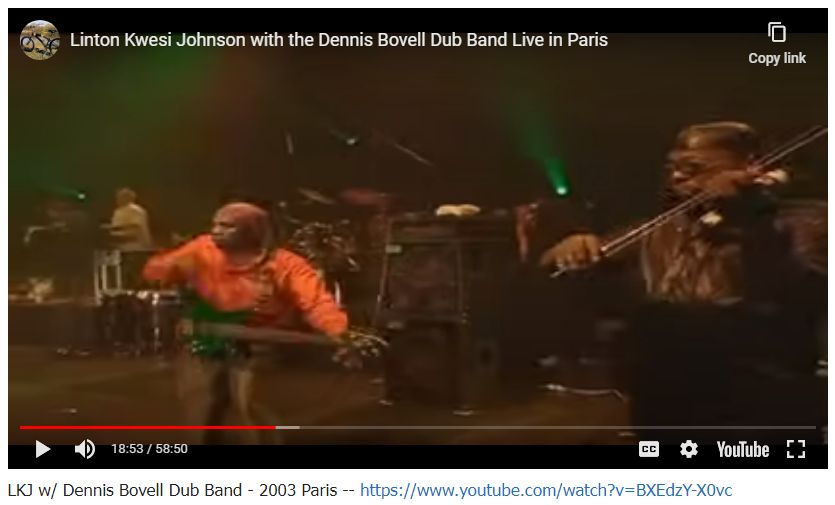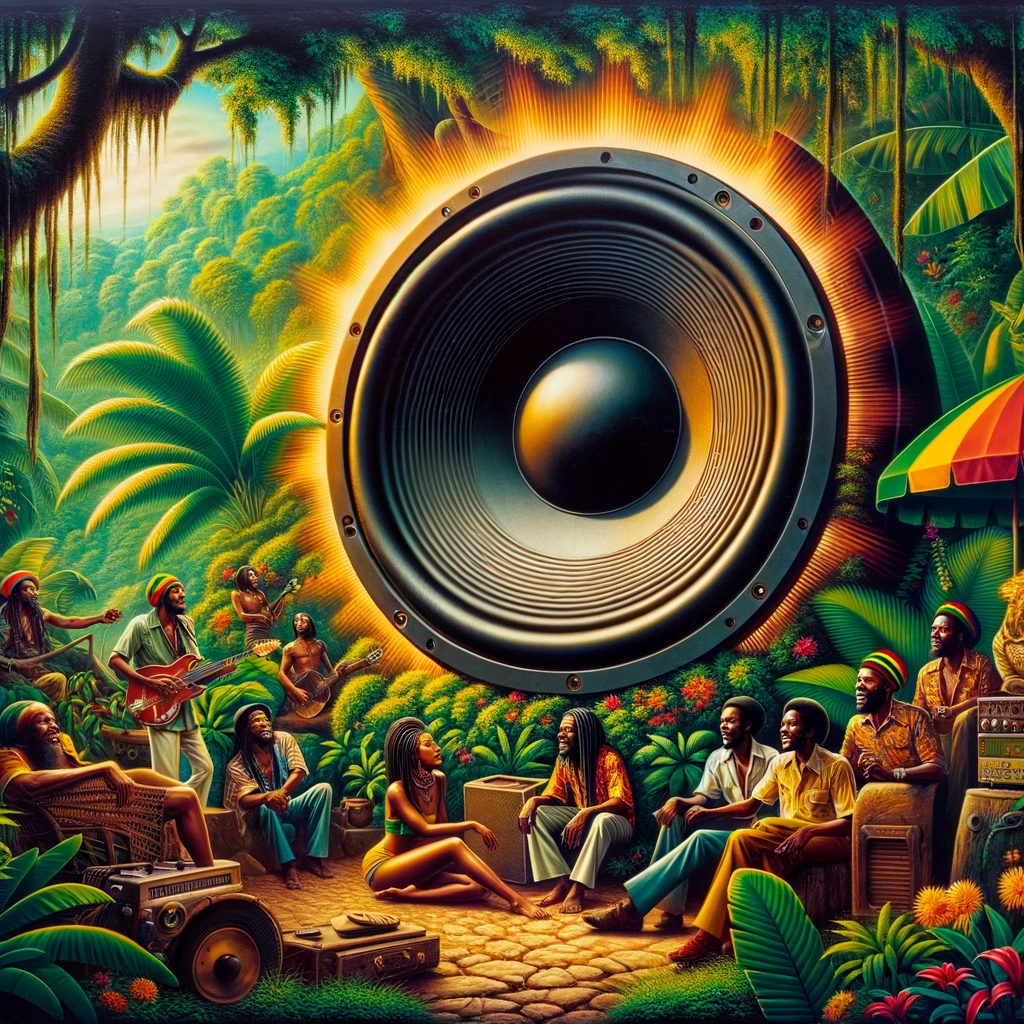Entrainment of Bass – Igziabeher, Let Jah Be Praised
Many recent fans are not aware of the recording technique preferred in Jamaica (and which was allowed on this 33 rpm album pressing) which was to forego the high-pass filter which otherwise smoothly rolls-off bass response below 50 Hz at some ramp, usually 12 dB/octave Butterworth. There may even be an RIAA recording standard for such. But this particular recording will send subwoofers into crazy-pumping mode, trying to blast out that ultra-low bass. Ultra-low, unfiltered bass was preferred at live events, to get the cabinet, floor and body vibrating, the club “pumping”. This was very much part of “the sound” at the beginning, now mostly lost, unknown, in fact unreproducible by most modern audio systems. LKJ touches on this spirit in Dred, Beat n Blood — at 11:00 into Linton Kwesi Johnson with the Dennis Bovell Dub Band Live in Paris 2003 (below)
The unrestricted bass was first made evident to me via a Pioneer SX-780 that sent port-vented JBL L166 woofers into overdrive with dangerous displacement. In comparison, Jensen sealed-cabinet woofers had self-limiting displacement. SX-780 ebay JBL-L166 ebay
BELOW: The LKJ + DBD 2003 has an interesting ‘bass overload’ solo and feature at around 18:00 in.

This is some amazing drumming. Precise. Clean. Emotional. Fitting. Uncommon and unexpected riffs. True Delight.
LKJ has always been an underrated poet/artist/activist in the world of reggae music. Fantastic performance and the DBD band was tight and mashing it down. I’ve seen a few other reggae performances online from Paris during the early millennium, and the fans in attendance really bring it !!
BELOW: LKJ speaks to the sound systems, record producers, “the sound” at around 17:00 in. At around 21:30 LKJ starts talking about “a talking bass”.

The Power of Ultra-Low Frequencies: Subwoofers and Mental Entrainment
In the realm of audio engineering and sound design, the pursuit of deeper, more immersive sound experiences has led to the development of technologies that harness the power of ultra-low, subsonic bass. These subwoofers are not merely tools for enhancing audio quality; they are intrinsic to mental entrainment, a mechanism that imparts vibrational energies to the body, influencing mind and mood in profound ways. This blog post delves into the science and art of subwoofers, exploring their attraction and impact on mental and emotional states, the differences between vented and sealed cabinets, and the significance of bass extension in achieving a full-range audio experience.
Subwoofers: The Heartbeat of Sound
Subwoofers are specialized loudspeakers designed to reproduce low-frequency sounds, typically below 100 Hz. These sounds, often felt more than heard, add depth and richness to audio experiences, creating a sense of immersion and physical presence. The appeal of subsonic bass lies in its ability to resonate with the body, delivering a tactile experience that engages the listener on a visceral level. This deep connection to sound is not just pleasurable but can also have therapeutic effects, aligning with the principles of mental entrainment.
Mental Entrainment: The Science of Vibration
Mental entrainment is the synchronization of the brain’s electrical activity with external rhythmic stimuli. Ultra-low frequencies produced by subwoofers can influence brainwave patterns, promoting states of relaxation, focus, or even heightened alertness. This phenomenon occurs because the brain tends to align its dominant frequency with the rhythm of external sounds, a process known as brainwave entrainment. Subsonic bass frequencies, typically below 20 Hz, can induce delta waves, which are associated with deep sleep, relaxation, and healing.
The Soothing Power of Bass Frequencies
The attraction to soothing bass frequencies can be explained by the human body’s natural response to rhythmic vibrations. Low-frequency sounds can induce a calming effect, reducing stress and anxiety by promoting the release of neurotransmitters such as serotonin and dopamine. This soothing power makes subwoofers a popular choice in various therapeutic settings, from sound baths to music therapy sessions, where the goal is to create a relaxing and healing environment.
Vented Woofers vs. Sealed Cabinets
The design of subwoofers plays a crucial role in their performance and the quality of sound they produce. There are two primary types of subwoofer enclosures: vented (ported) and sealed cabinets.
Vented Woofers: These subwoofers feature a port or vent that allows air to move in and out of the cabinet. This design enhances efficiency and allows the subwoofer to produce louder, deeper bass with less power. Vented woofers are known for their ability to deliver extended bass response, making them ideal for applications where maximum bass output is desired.
Sealed Cabinets: In contrast, sealed subwoofers have an airtight enclosure, which results in tighter, more accurate bass. The lack of a port means that sealed subwoofers typically require more power to achieve the same output as vented designs, but they offer better transient response and are often preferred in high-fidelity audio systems where precision and clarity are paramount.
Bass Extension: Reaching the Depths of Sound
Bass extension refers to a subwoofer’s ability to reproduce the lowest frequencies in the audio spectrum. Subwoofers with good bass extension can reach frequencies as low as 20 Hz or even lower, providing a fuller, more encompassing sound experience. The depth and quality of bass extension are critical for creating a realistic and immersive audio environment, whether in home theaters, concert venues, or personal listening spaces.
The Impact of Subsonics on Mind and Mood
Subsonic frequencies, those below the threshold of human hearing (20 Hz), have unique effects on the mind and mood. These ultra-low frequencies can induce a range of psychological and physiological responses, from feelings of awe and wonder to deep relaxation and tranquility. The physical sensation of subsonic vibrations can also stimulate the body’s sensory systems, enhancing the overall emotional impact of the audio experience.
Research has shown that subsonic frequencies can influence heart rate, breathing patterns, and even brainwave activity, making them powerful tools for both entertainment and therapeutic purposes. In music production, incorporating subsonics can add a layer of depth and emotional resonance that elevates the listening experience to new heights.
Conclusion
The exploration of ultra-low, subsonic bass and subwoofers reveals a fascinating intersection of technology, psychology, and art. By understanding the mechanisms through which these low frequencies impart vibrational energies to the body and influence the mind, we can appreciate the profound impact of subwoofers on our mental and emotional well-being. Whether through the soothing power of bass frequencies, the precision of sealed cabinets, or the extended reach of vented woofers, subwoofers continue to shape our auditory experiences and connect us to the primal rhythms of sound.